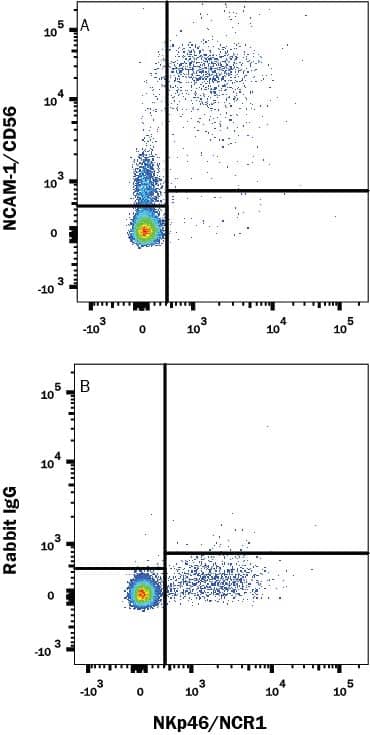Human NCAM-1/CD56 Antibody
R&D Systems, part of Bio-Techne | Catalog # MAB24086


Key Product Details
Species Reactivity
Applications
Label
Antibody Source
Product Specifications
Immunogen
Leu20-Pro603 and Glu636-Asn741
Accession # NP_001070150
Specificity
Clonality
Host
Isotype
Scientific Data Images for Human NCAM-1/CD56 Antibody
Detection of Human NCAM‑1/CD56 by Western Blot.
Western blot shows lysates of human brain (motor cortex) tissue. PVDF membrane was probed with 0.5 µg/mL of Rabbit Anti-Human NCAM-1/CD56 Monoclonal Antibody (Catalog # MAB24086) followed by HRP-conjugated Anti-Rabbit IgG Secondary Antibody (Catalog # HAF008). A specific band was detected for NCAM-1/CD56 at approximately 140 kDa (as indicated). This experiment was conducted under reducing conditions and using Immunoblot Buffer Group 1.Detection of NCAM-1/CD56 in Human Peripheral Blood by Flow Cytometry.
Human peripheral blood was stained with either (A) Rabbit Anti-Human NCAM-1/CD56 Monoclonal Antibody (Catalog # MAB24086) or (B) Rabbit IgG Isotype Control (Catalog # MAB1050) followed by Anti-Rabbit IgG APC-conjugated secondary antibody (Catalog # F0111) and Mouse Anti-Human NKp46 PE-conjugated Monoclonal Antibody (Catalog # FAB1850P). View our protocol for Staining Membrane-associated Proteins.Applications for Human NCAM-1/CD56 Antibody
CyTOF-ready
Flow Cytometry
Sample: Human Peripheral Blood
Western Blot
Sample: Human brain (motor cortex) tissue
Formulation, Preparation, and Storage
Purification
Reconstitution
Formulation
Shipping
Stability & Storage
- 12 months from date of receipt, -20 to -70 °C as supplied.
- 1 month, 2 to 8 °C under sterile conditions after reconstitution.
- 6 months, -20 to -70 °C under sterile conditions after reconstitution.
Background: NCAM-1/CD56
Neural cell adhesion molecule 1 (NCAM-1) is a multifunctional member of the Ig superfamily. It belongs to a family of membrane-bound glycoproteins that are involved in Ca++ independent cell matrix and homophilic or heterophilic cell-cell interactions. NCAM-1 specifically binds to heparan sulfate proteoglycans (1), the extracellular matrix protein agrin (2), and several chondroitin sulfate proteoglycans that include neurocan and phosphocan (3). There are three main forms of human NCAM-1 that arise by alternate splicing. These are designated NCAM-120/NCAM-1 (761 amino acids [aa]), NCAM‑140 (848 aa), and NCAM-180 (1120 aa). NCAM-120 is GPI-linked, while NCAM‑140 and NCAM-180 are type I transmembrane glycoproteins (4 - 6). Additional alternate splicing adds considerable diversity to all three forms, and extracellular proteolytic processing is possible for NCAM-180 (7 ‑ 8). NCAM-1 is synthesized as a 761 aa preproprecursor that contains a 19 aa signal sequence, a 722 aa GPI-linked mature region, and a 20 aa C-terminal prosegment (4). The molecule contains five C-2 type Ig-like domains and two fibronectin type-III domains. Human to mouse, NCAM-1 is 93% aa identical. NCAM-1 appears to be highly sialylated. The polysialyation of NCAM-1 reduces its adhesive property and increases its neurite outgrowth promoting features (9). NCAM-1 in the adult brain shows a decline of sialylation relative to earlier developmental periods. In regions that retain a high degree of neuronal plasticity, however, the adult brain continues to express polysialylation-NCAM-1, suggesting sialylation of NCAM-1 is involved in regenerative processes and synaptic plasticity (10 - 13).
References
- Burg, M.A. et al. (1995) J. Neurosci. Res. 41:49.
- Storms, S.D. and U. Rutishauser (1998) J Biol. Chem. 273:27124.
- Margolis, R.K. et al. (1996) Perspect. Dev. Neurobiol. 3:273.
- Dickson, G. et al. (1987) Cell 50:1119.
- Lanier, L.L. et al. (1991) J. Immunol. 146:4421.
- Hemperly, J.J. et al. (1990) J. Mol. Neurosci. 2:71.
- Rutishauser, U.and C. Goridis (1986) Trends Genet. 2:72.
- Vawter, M.P. et al. (2001) Exp. Neurol. 172:29.
- Rutihauser, U. (1990) Adv. Exp. Med. Biol. 265:179.
- Becker, C.G. et al. (1996) J. Neurosci. Res. 45:143.
- Doherty, P. et al. (1995) J. Neurobiol. 26:437.
- Eckardt, M. et al. (2000) J. Neurosci. 20:5234.
- Muller, D. et al. (1996) Neuron 17:413.
Long Name
Alternate Names
Gene Symbol
UniProt
Additional NCAM-1/CD56 Products
Product Documents for Human NCAM-1/CD56 Antibody
Product Specific Notices for Human NCAM-1/CD56 Antibody
For research use only
